Red Swamp Crayfish
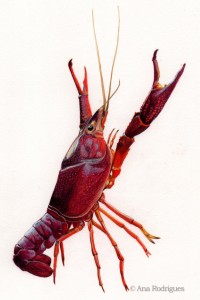 Native range: Known as Louisiana crayfish, crawdad, and mudbug, Procambarus clarkii is native to the south central United States and northeastern Mexico.
Native range: Known as Louisiana crayfish, crawdad, and mudbug, Procambarus clarkii is native to the south central United States and northeastern Mexico.
Invasive range and pathways: The red swamp crayfish is the most widely introduced crayfish in the world, found on every continent except for Australia and Antarctica. It is widespread in the United States, from Arizona, California, Georgia, Hawaii, Idaho, Indiana, Maryland, North Carolina, Nevada, Ohio, Oregon, South Carolina, Utah, to Virginia. Populations have even been found as far north as Washington. Spread is likely through its use as bait and aquarium releases.
Habitat: The red swamp crayfish is found in calm freshwater such as ponds, swamps, marshes, irrigation systems, rice patties, slowly flowing rivers, and lakes.
Description: The red swamp crayfish is typically dark red in color with raised spots along the body and a black stripe across the back. Occasionally, claws or body are blue. Adults vary in length between 2 and 5 inches.
Impacts: The red swamp crayfish eats tadpoles and bass and trout eggs. It also consumes plants that line the bottoms of lakes and streams. Its activity can make clear bodies of water more turbid and cause stream-bank erosion. Research and strong policies are needed to help prevent the import of invasive crayfish and control, eradicate, and prevent the spread of established species.
In 1765, after refusing to swear allegiance to the British Crown, the French Catholic settlers of New Acadia (Nova Scotia) were exiled by the British. More than 10,000 Acadians resettled in the bayous of southwestern Louisiana. There they discovered the red swamp crayfish, sweet reminder of the lobsters of the north and of the écrevisse, the native crayfish of France, as Cajun folktales and recipes reveal. They spun a tale of how the crayfish came to Louisiana: The lobsters were huge up in Acadia, as big as a man. Only one chose to follow the Cajuns into exile. During the long and difficult trip, it grew smaller and smaller. By the time the exiles reached Louisiana, the lobster was only a few inches long.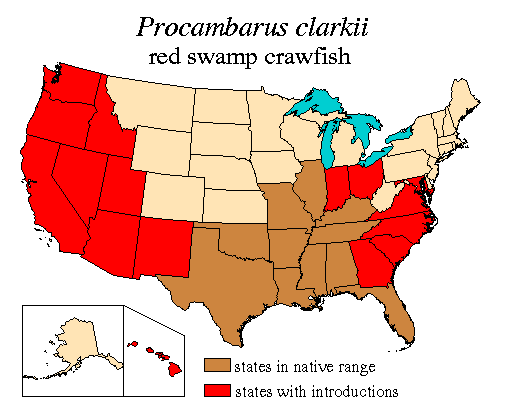
Soon the Cajuns were farming Louisiana crayfish in their rice fields, using an ancient practice developed by the Chinese. Procambarus clarkii seems particularly suited to cultivation––able to colonize disturbed habitats unsuitable for the native crayfish––and this led, in the 20th century, to its introduction across the US and around the world,P. clarkii is marketed by biological supply companies for teaching and research. It exhibits different color morphs, including white, blue, and orange, which are sold in pet stores in Europe. It has been introduced for aquaculture in Arizona, California, Georgia, Hawaii, Idaho, Indiana, Maryland, North Carolina, Nevada, Ohio, Oregon, South Carolina, Utah and Virginia. In Washington it appeared after it was sold as fish bait. (Crayfish easily fall off of the hook, so casting should be slow. Unused live bait should never be dumped into a body of water. Or on the shore: individuals are reported to be able to cross many miles of relatively dry ground, especially in wet seasons.)
The species has also been introduced for aquaculture to Central and South America; Europe (Spain); East Asia (China; Japan, as a food source for bullfrogs––another American import––now crayfish are common family pets); and Africa (Kenya; Egypt; Nigeria––because it prefers many aquatic and semi-aquatic snails that are vectors for human pathogens such as schistosomiasis). A recent paper in PLoS ONE noted that crayfish may be moving out of ponds in the footprints of hippos, where perhaps they’re being harvested.The result of all this interchange? The ultimate irony: Louisiana crawfish production has decreased in recent years due to increased imports of Red swamp crayfish from China so cheap they undercut the native ones. China, where rice-fish companion farming originated long ago, is now the world’s leading producer of North American red swamp crayfish.

Crawdad Song
by Woody Guthrie
You get a line and I’ll get a pole, honey.
You get a line and I’ll get a pole, babe.
You get a line and I’ll get a pole
And we’ll go fishin’ at the crawdad hole,
Honey, oh babe, oh mine.
Yonder come a man with a sack on his back, honey.
Yonder come a man with a sack on his back, babe.
Yonder come a man with a sack on his back,
Packin’ all the crawdads he can pack,
Honey, oh babe, oh mine.He fell down and broke that sack, honey.
He fell down and broke that sack, babe.
He fell down and broke that sack.
‘Twas a sight to see the crawdads back to back,
Honey, oh babe, oh mine.What you gonna do when the lake goes dry, honey?
What you gonna do when the lake goes dry, babe?
What you gonna do when the lake goes dry,
Sit on the bank and watch the crawdads die?
Honey, oh babe, oh mine.I heard the duck say to the drake, honey,
I heard the duck say to the drake, babe,
I heard the duck say to the drake, “There ain’t no crawdads in this lake.”
For more on this invasive species, including a recipe for crayfish étouffée take a look at News From Sparkling Lake.
Rusty Crayfish
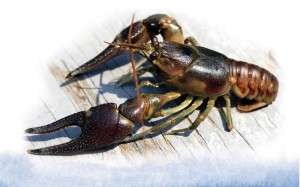 Native range: The rusty crayfish, Orenectes rusticus, is a native of the Ohio River, in the states of Ohio, Kentucky, Michigan, and Indiana.
Native range: The rusty crayfish, Orenectes rusticus, is a native of the Ohio River, in the states of Ohio, Kentucky, Michigan, and Indiana.
Invasive range and pathways: The species is invasive in many states from Maine to New Mexico and all of the Great Lakes. It has likely spread through bait buckets and aquarium releases.
Habitat: The rusty crayfish is a generalist species that inhabits permanent streams and lakes.
Description: Dark rusty spots are typically found on both sides of carapace, though they may not be apparent in all populations or individuals. Adults up to four inches. The grayish green to reddish brown claws are large and generally smooth.
Impacts: The rusty crayfish has displaced local crayfish in numerous waterways throughout its invasive range. Hybridization between O. rusticus and other, native Orenectes species can add harm to the damage already caused by competition and ecological displacement.
Other Invasives
In many areas, the number of invasive crayfish species outnumber the natives. In Vermont, for example there are five invasive species, and only three native ones. For a short list of invasive crayfish, try the USGS Nonindigenous Aquatic Species website. The maps of the most widespread invaders are here. More detailed information about nonnative crayfish and other crustaceans can be found here.
Harvest
Baited traps are generally the best way to catch crayfish. In many areas, peak season is from March to July, though they can be caught any time of the year. The “pyramid trap,” constructed from wire formed into a three sided form with three entrance funnels, is the industry standard of crawfish traps. Natural fish baits and formulated baits, which are some of the most costly aspects of production, are needed to lure crawfish into traps. Common fish used are Clupeid or “sardine-like” fishes, such as gizzard shad and Gulf menhaden. Common carp, buffalofish, herring, suckers and catfish are also used. Traps are placed in rows to facilitate the harvesting by boat. The distance between rows is based on the density of traps, but a spacing of 40 to 60 feet between rows and individual traps is most common. Traps are usually emptied 24 or 48 hours after baiting.
Gretchen Hansen, who has worked to remove rusty crayfish from Wisconsin’s Sparkling Lake, told us that they used minnow traps (above) with expanded openings to catch crayfish. (Using an oar to expand the opening works well.)
Learn more about harvesting crayfish here.
Recipes
Crawfish Boil
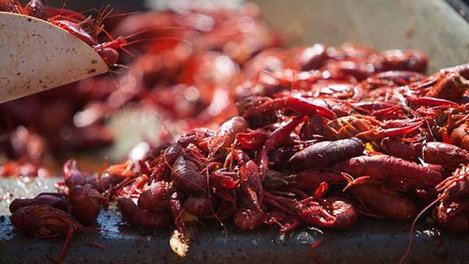
Louisiana crawfish, also known as crawdads or mudbugs, are usually boiled in a large pot with heavy seasoning and potatoes, corn, and onion. The methods are varied, but the crawfish boil is a Southern tradition that would do well just about anywhere crayfish have invaded.
Click here for the full recipe.
For a charming alternative, with the essential ingredient of relaxing with company, see, Nola Cuisine.
Swedish Crayfish
From Goteborg Daily
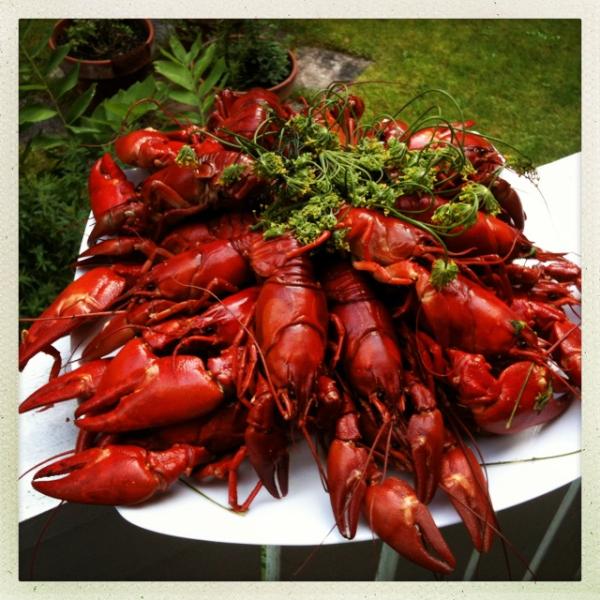
Click here for the full recipe.
Sparkling Lake Étouffée
See News from Sparkling Lake for recipes for a low country boil and crawfish étouffée, adapted for northern, invasive climes.



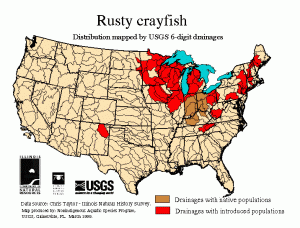

























{ 4 comments… read them below or add one }
Dear Whom This May Concern,
My name is Alexis Exum and I work for Dr. Herberholz at the University of Maryland. We do research on P. Clarkii crayfish and were hoping you may be able to put us in touch with an organization and/or person that traps or catches them. We are looking for another source for our lab and figured us buying them for research from someone trying to rid the environment of an invasive species would be good for everyone. Please let me know if you know of anyone or any association that could help us. Thanks!
Best,
Alexis Exum
Dear Mr. Exum,
I live in Townsend, Delaware our pond is invaded with crayfish and tadpole bullfrogs. You can have all you want for research. Contact me if interested.
Thank you,
Kim Valencik
Hi Kim!
I’m sorry it took me such a long time to get back to you. I did not see this reply. We are still looking for crayfish (Procambarus Clarkii) so if you still have crayfish available we would love to purchase from you. Please e-mail me at exumac@umd.edu.
Thank you!
Alexis E.
My son and I have been catching crayfish all week in Arizona, at a river called San Pedro. I found your site when looking for ways to cook em and eat em. We have been catching both rusty and red crayfish. Thanks for great info.